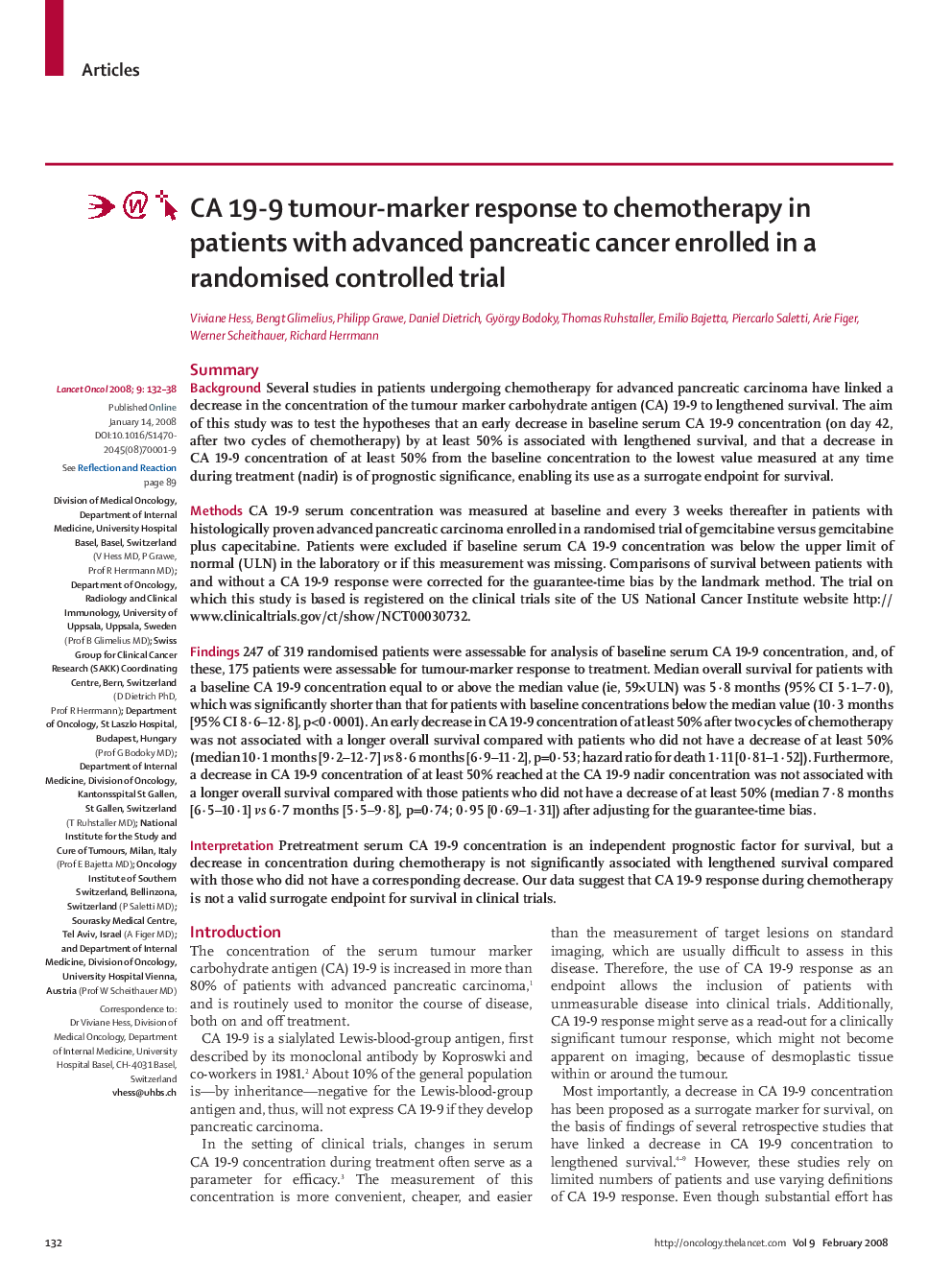| Article ID | Journal | Published Year | Pages | File Type |
|---|---|---|---|---|
| 3995373 | The Lancet Oncology | 2008 | 7 Pages |
SummaryBackgroundSeveral studies in patients undergoing chemotherapy for advanced pancreatic carcinoma have linked a decrease in the concentration of the tumour marker carbohydrate antigen (CA) 19-9 to lengthened survival. The aim of this study was to test the hypotheses that an early decrease in baseline serum CA 19-9 concentration (on day 42, after two cycles of chemotherapy) by at least 50% is associated with lengthened survival, and that a decrease in CA 19-9 concentration of at least 50% from the baseline concentration to the lowest value measured at any time during treatment (nadir) is of prognostic significance, enabling its use as a surrogate endpoint for survival.MethodsCA 19-9 serum concentration was measured at baseline and every 3 weeks thereafter in patients with histologically proven advanced pancreatic carcinoma enrolled in a randomised trial of gemcitabine versus gemcitabine plus capecitabine. Patients were excluded if baseline serum CA 19-9 concentration was below the upper limit of normal (ULN) in the laboratory or if this measurement was missing. Comparisons of survival between patients with and without a CA 19-9 response were corrected for the guarantee-time bias by the landmark method. The trial on which this study is based is registered on the clinical trials site of the US National Cancer Institute website http://www.clinicaltrials.gov/ct/show/NCT00030732.Findings247 of 319 randomised patients were assessable for analysis of baseline serum CA 19-9 concentration, and, of these, 175 patients were assessable for tumour-marker response to treatment. Median overall survival for patients with a baseline CA 19-9 concentration equal to or above the median value (ie, 59×ULN) was 5·8 months (95% CI 5·1–7·0), which was significantly shorter than that for patients with baseline concentrations below the median value (10·3 months [95% CI 8·6–12·8], p<0·0001). An early decrease in CA 19-9 concentration of at least 50% after two cycles of chemotherapy was not associated with a longer overall survival compared with patients who did not have a decrease of at least 50% (median 10·1 months [9·2–12·7] vs 8·6 months [6·9–11·2], p=0·53; hazard ratio for death 1·11 [0·81–1·52]). Furthermore, a decrease in CA 19-9 concentration of at least 50% reached at the CA 19-9 nadir concentration was not associated with a longer overall survival compared with those patients who did not have a decrease of at least 50% (median 7·8 months [6·5–10·1] vs 6·7 months [5·5–9·8], p=0·74; 0·95 [0·69–1·31]) after adjusting for the guarantee-time bias.InterpretationPretreatment serum CA 19-9 concentration is an independent prognostic factor for survival, but a decrease in concentration during chemotherapy is not significantly associated with lengthened survival compared with those who did not have a corresponding decrease. Our data suggest that CA 19-9 response during chemotherapy is not a valid surrogate endpoint for survival in clinical trials.
